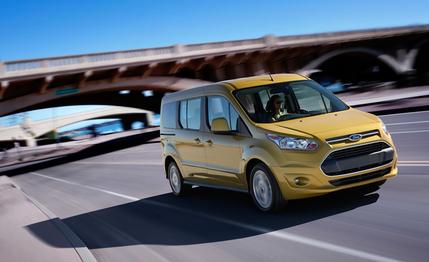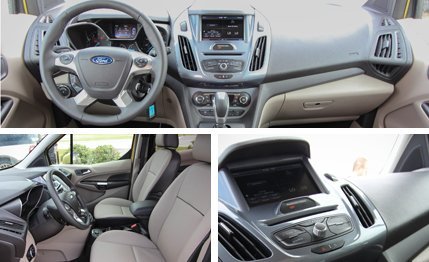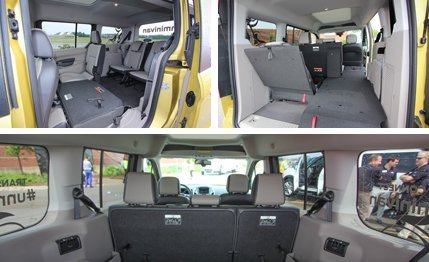
 First Drive Review
First Drive Review
By every reasonable definition, the 2014 Ford Transit Connect wagon is a minivan. It’s a van. It’s small. Ergo, it’s a minivan. Duh. Yet Ford is touting it as the “unminivan,” even turning the term into a hashtag for marketing purposes.
Yet by suggesting the Transit Connect wagon is something it’s not or, more accurately, saying it isn’t something it is, Ford is muddling what makes the vehicle unique. It’s a delightfully straightforward, fuel-efficient, and space-efficient minibus that’s relatively low on frills but very high on usefulness. It is equal parts utility van and compact car. As such, it stands in stark contrast to the heavy, bloated road whales currently being marketed under that modern misnomer of “minivan.” Okay, we suppose, in that respect, it is indeed the “unminivan.”
Marketing bluster aside, the Transit Connect is generally quite likable. Based on Ford’s global C platform, which also underpins the Focus and Escape, among other products, the Transit Connect drives more like a small car than a minivan or utility vehicle, with surprisingly quick turn-in and some semblance of road feel through the wheel. Our test drive was limited to the confines of Ford’s Dearborn proving ground, where the Ford hounds assured us we would maintain sane speeds, but we came away impressed with the Transit Connect’s light-on-its-feet demeanor and the way in which it generally quashed body motions. Thanks to its unique suspension tuning compared with the cargo van, added sound insulation, and fully lined ceiling and walls, it is considerably quieter than the cargo model with which it shares its slab-sided body, highly stylized dashboard, and fuel-efficient powertrains.


We sampled a short-wheelbase, five-passenger wagon with the optional 178-hp, 1.6-liter EcoBoost four-cylinder engine and a long-wheelbase, seven-passenger model powered by its only engine, the 169-hp, 2.5-liter four-cylinder. Even with three aboard, the short-wheelbase EcoBoost model felt the friskiest—no surprise there—with some turbo lag but sufficient scoot once the turbo rush kicked in. The 2.5, for its part, didn’t seem to lack power under our benign driving regimen, but it might want for more oomph if more seats were filled. And for what it’s worth, the EcoBoost engine—a $795 option on the short-wheelbase model—achieves 1 to 2 more mpg than the 2.5, according to EPA estimates.
Practically a Minivan
Most Transit Connect wagon customers will be satisfied with merely adequate performance; for them, the ability to carry people and things is far more important. Ingress and egress are a cinch—there’s no ascent to the driver’s seat, you simply open the tall door and slide in sideways. The rear seats are set equally low in the structure, amplifying the impression of Notre Dame–like headroom, although taller passengers might be looking at the tops of their knees. Forget putting the rest of the basketball squad in the far back—that space is strictly for kids. Furthermore, the second-row seats are rather cumbersome to fold flat and/or gain access to the third row.
Outward vision is fantastic to the front and side and is certainly better than the cargo model’s out the rear. The cabin’s ergonomics will be familiar to anyone who’s driven other recent Ford cars. The instruments are housed in a hexagonal cluster, and ancillaries are displayed within a cowl-covered information screen (with available MyFord Touch and Sync) perched above banks of stylized audio and climate controls. As in the cargo version, the Transit Connect wagon features a full-width, aircraft-style shelf above the front visors for small items like, say, an iPad to show movies to the kids, since the Transit Connect does not offer a rear-seat entertainment system. And, of course, all-in cargo space (104.2 cubic feet of it in the long-wheelbase version) is pretty incredible. Thank you, flat-folding seats, T-square walls, and sky-high roof.


But alas, there is a palpable cheapness inside that one never experiences in other modern minivans, evidenced in glimpses of body color in the A-pillars, exposed seat hardware, and hard plastics covering pretty much everything that you can’t sit or stand on, among other things. Many of the myriad options taken for granted in minivan-dom—such as available multizone automatic climate control, premium audio systems, power-sliding doors and liftgates, and sunroofs that open—are missing from the Transit Connect wagon.
Then there’s the matter of price. At $25,520, the cheapest short-wheelbase, five-passenger wagon costs almost as much as a loaded Mazda 5 Grand Touring or base C-Max hybrid, the latter achieving roughly 17 more mpg. A fully dressed seven-passenger model with MyFord Touch, leather seats, and a fixed-glass sunroof can surpass $34,000, at which point any number of “proper” minivans, to say nothing of the V-6–powered, seven-passenger Flex, represent highly appealing alternatives.
If there is a sweet spot for the Transit Connect wagon, it would be in two-row, short-wheelbase form with EcoBoost and Sync. In that five-seat guise, this wagon doesn’t take itself too seriously, with favorable dynamics, fuel efficiency, and bread-box utility. Anything else, and it’s trying to be a real minivan.